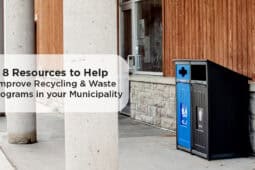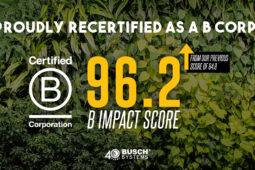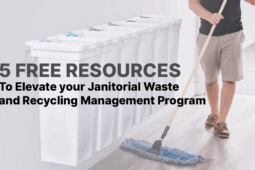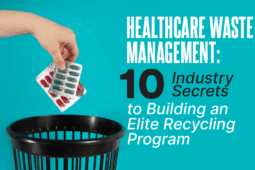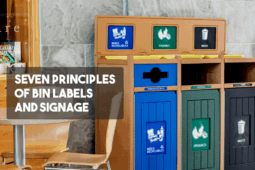A Recycling & Waste Management Glossary
The Waste Management & Recycling world is rich with industry specific terms.
We’ve compiled a list of some obvious (Mixed Recycling), not-so-obvious (Cullet-not a cute mullet), and some stomach turning (Night Soil, trust us…) terms that you may or may not be familiar with.
Enjoy!
![]()
AAA
![]()
Aerobic Composting
A method of composting organic wastes using bacteria that need oxygen. This requires that the waste is exposed to air, either via turning or by forcing air through pipes that pass through the material.
Anaerobic Digestion
A method of composting that does not require oxygen. This composting process produces methane.
BBB
![]()
Biodegradable Material
Any organic material that can be broken down by microorganisms into simpler, more stable compounds. Most organic wastes (e.g., food, paper) are biodegradable.
Bulky Waste
Large wastes such as appliances, furniture, and trees and branches that cannot be handled by routine MSW processing methods.
![]()
CCC
![]()
Co-disposal
The disposal of different types of waste in one area of a landfill or dump. For instance, sewage sludges may be disposed of with regular solid wastes.
Cogeneration
Production of both electricity and steam from one facility, from the same fuel source.
Collection
the process of picking up wastes from residences, businesses, or a collection point, loading them into a vehicle and transporting them to a processing, transfer, or disposal site
C & D Waste
Generated by construction and demolition activity and is also referred to as CRD (construction, renovation and demolition) waste. It includes wood, scrap metal, drywall, concrete, brick and various packaging materials and can make up as much as 25% of the solid waste going to landfill.
Combustibles
Burnable materials in the waste stream, including paper, plastics, wood, and food and garden wastes.
Commingled
Mixed recyclables that are collected together after having been separated from mixed MSW.
Compaction
Reduction of the bulk of solid waste by rolling and tamping
Corrugated Cardboard
Cardboard with corrugations (can be glued to flat cardboard on one or both sides)
Cullet
Broken or waste glass suitable for re-melting
Curbside Collection
The collection of compostables, recyclables, or trash at the edge of a sidewalk in front of a residence or shop.
![]()
DDD
![]()
Disposal
The final handling of solid waste, following collection, processing, or incineration. Disposal most often means placement of wastes in a dump or a landfill.
Diversion Rate
The proportion of waste material diverted for recycling, composting, or reuse and away from landfilling or incineration.
Drop-Off Center
An area or facility for receiving compostables or recyclables that are dropped off by waste generators.
![]()
EEE
![]()
Environmental Impact Assessment (EIA)
An evaluation designed to identify and predict the effects of an action or a project on the environment and human health and well-being. Can include risk assessment as a component, along with economic and land use assessment.
Environmental Risk Assessment (EnRA)
An evaluation of the interactions of agents, humans, and ecological resources. Comprised of human health risk assessment and ecological risk assessment, typically evaluating the probabilities and magnitudes of harm that could come from environmental contaminants.
![]()
FFF
![]()
Food Waste
Uneaten food and food preparation wastes from residences and commercial establishments such as grocery stores, restaurants, and produce stands, institutional cafeterias and kitchens, and industrial sources like employee lunchrooms.
![]()
GGG
![]()
Garbage
In everyday usage, refuse in general. Some MSWM manuals use garbage to mean “food wastes,” although this usage is not common.
Grasscycling
Source reduction activities in which grass clippings are left on the lawn after mowing
Green Remediation
The practice of considering all environmental effects of remedy implementation and incorporating options to maximize the net environmental benefit of cleanup actions.
![]()
HHH
![]()
Household Hazardous Waste
Residential waste that may be harmful to the environment or human health. Examples of household hazardous waste include paints, solvents, automobile fluids, pesticides and herbicides
Household Organic Waste
Includes food waste and various compostable materials generated by a household. Source-separated household organic waste is separated by residents from other household waste before disposal. When leaf and yard waste is included, organic waste makes up as much as 40% of the residential waste stream.
Humus
The end product of composting also called compost.
![]()
III
![]()
IC&I Waste
Generated by the institutional, commercial and industrial sectors
Integrated Solid Waste Management
Coordinated use of a set of waste management methods, each of which can play a role in an overall MSVVM plan.
In-Vessel Composting
Composting in an enclosed vessel or drum with a controlled internal environment, mechanical mixing, and aeration.
Leaf & Yard Waste
Generated through gardening and landscaping activity. This material is readily processed through open windrow composting (a cost-effective composting method involving piling compostable matter in rows). Leaf and yard waste makes up as much as 10% or more of the residential waste stream.
![]()
MMM
![]()
Manual Landfill
a landfill in which most operations are carried out without the use of mechanized equipment.
Market Waste
Primarily organic waste, such as leaves, skins, and unsold food, discarded at or near food markets.
Materials Recovery
Obtaining materials that can be reused or recycled.
Mixed Glass
Recovered container glass that is not sorted into categories (e.g. color, grade).
Mixed Metals
Recovered metals not classified into categories such as aluminum, tin or steel cans or ferrous or non-ferrous metals. (EPA Glossary)
Mixed Paper
Recovered paper not sorted into categories such as old magazines, old newspapers, old corrugated boxes, etc. (EPA Glossary)
Mixed Plastic
Recovered plastic unsorted by category. (EPA Glossary)
Mixed waste
Unsorted materials that have been discarded into the waste stream.
Monofill
A landfill that is intended for one type of waste only.
MSW
Municipal solid waste.
MSWM
Municipal solid waste management.
Materials recovery facility (MRF)
A plant for separating commingled recyclables by manual or mechanical means. Some MRFs are designed to separate recyclables from mixed MSW. MRFs then bale and market the recovered materials.
![]()
NNN
![]()
Night Soil
Human excreta. Human waste. Poop. Yeah, we know, gross…
![]()
OOO
![]()
Office Paper
Used or discarded high-grade white paper and manila paper, including paper utilized for file folders, tab cards, writing, typing, printing, computer printing, and photocopying, which is suitable for recycling and which has a minimum of contamination
Other Glass
Recyclable glass from furniture, appliances, and consumer electronics. Does not include glass from transportation products (cars trucks or shipping containers) and construction or demolition debris.
Other Paper
For Recyclable paper from books, third-class mail, commercial printing, paper towels, plates and cups; and other non-packaging paper such as posters, photographic papers, cards and games, milk cartons, folding boxes, bags, wrapping paper, and paperboard. Does not include wrapping paper or shipping boxes.
Other Plastics
Recyclable plastic from appliances, eating utensils, plates, containers, toys, and various kinds of equipment. Does not include heavy-duty plastics such as yielding materials.
Other Solid Waste
Recyclable nonhazardous solid wastes, other than municipal solid waste, covered under Subtitle D of RARA.
![]()
PPP
![]()
Paper Processor/Plastics Processor
The intermediate facility where recovered paper or plastic products and materials are sorted, decontaminated, and prepared for final recycling.
Pay-As-You-Throw/Unit-Based Pricing (PAYT)
Systems under which residents pay for municipal waste management and disposal services by weight or volume collected, not a fixed fee.
Post-Consumer
A term used to describe material that is being reused/recycled after it has been in the consumer’s hands (e.g., a newspaper going back to the paper mill to be recycled into new recycled content paper products). Material or product used by the consumer for its original purpose and then discarded.
Pre-Consumer
A term used to describe material that is being reused/recycled before it ever goes to market (e.g. paper scraps off of a paper mill floor going back into the next batch of paper). Waste material generated during the manufacturing process
Polyethylene Terephthalate (PETE)
A type of plastic used to make soft drink bottles and other kinds of food containers. PET is also used to make fabric. Coded #1.
![]()
RRR
![]()
Reclamation
Restoration of materials found in the waste stream to a beneficial use which may be for purposes other than the original use.
Resources Recovery Facility
A facility that is utilizing processes to reclaim energy from municipal solid waste.
Recyclable Materials
Paper, cardboard, metal, glass and some plastics, for which secondary markets are well developed.
Residential Waste
Generated by both single-family households and multi-family buildings (which usually receive different collection services). It typically consists of about 40% recyclable materials, 40% organic materials, 10% bulky goods and 10% other materials
![]()
SSS
![]()
Secondary Materials
Materials that have been manufactured and used at least once and are to be used again.
Single Stream Collection
Collection system where recyclables are fully commingled, mixing fiber (papers) and containers (glass bottles, metal cans, and plastic containers)
SMART (Save Money and Reduce Trash)
Another name for Pay-As-You-Throw – Systems under which residents pay for municipal waste management and disposal services by weight or volume collected, not a fixed fee.
![]()
TTT
![]()
Transfer Station
Any location or structure, whether located on land or water, where more than ten cubic yards of solid waste, generated elsewhere, may be stored for transfer or transferred from transportation units and placed in other transportation units for movement to another location.
This is regardless whether or not such waste is stored at the location before transfer.
![]()
VVV
![]()
Vermicomposting
The process by which worms convert organic waste into worm castings – the dark, fertile, granular excrement of a worm. Castings are rich in plant nutrients.
![]()
WWW
![]()
Waste Characterization
Identification of chemical and microbiological constituents of a waste material.
Waste Exchange
Arrangement in which companies exchange their wastes for the benefit of both parties. See also Materials Exchange
![]()
YYY
![]()
Yard Trimmings
Leaves, grass clippings, weeds, branches up to one (1″) inch in diameter and prunings from yards or gardens.
![]()
ZZZ
![]()
Zero Waste
Zero Waste is a goal that is both pragmatic and visionary, to guide people to emulate sustainable natural cycles, where all discarded materials are resources for others to use. Zero Waste means designing and managing products and processes to reduce the volume and toxicity of waste and materials, conserve and recover all resources, and not burn or bury them. Implementing Zero Waste will eliminate all discharges to land, water or air that may be a threat to planetary, human, animal or plant health.
![]()
Sources
http://www.epa.gov/OCEPAterms/
http://www.gdrc.org/uem/waste/swm-glossary.html
![]()


